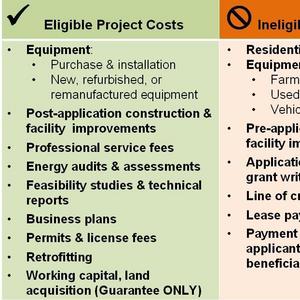USDA REAP sinks $3.4 billion into rural economies

Biomass Thermal Energy Council
June 25, 2014
BY Anna Simet
Though the USDA Rural Energy for America Program has been hugely successful since it was first implemented in the 2002 Farm Bill, numerous changes have been implemented over the years in order to maximize program value.
To date, the program has put over $3.4 billion into rural economies, according to Anthony Crooks, USDA energy specialist.
During a webinar sponsored by the Biomass Thermal Energy Council, Crooks provided an overview of REAP, identified program changes for 2014 and 2015, and emphasized the significant benefits the program has had on ag producers, small rural businesses and the bioenergy supply chain.
REAP is currently funded with $50 million in mandatory funding annually, Crooks said, to provide grants, guaranteed loans and combination grant/guaranteed loans. “If funds are not exhausted for a respective year, they roll over to the next,” he said, adding that annual funds are divvied up between 47 state offices, and dollars that are not used up in each respective state are pooled and used for one final round of funding.
Though REAP has specific program funding windows, applications are accepted year-round, and funding is awarded on a competitive bases. “[REAP] will not pay for anything you’ve done prior to submitting an application,” Crooks advised.
Advertisement
Advertisement
REAP grants and guarantees may be used individually or in combination to finance up to 75 percent of a project's total cost. Grants cannot finance more than 25 percent of a project or $500,000, whichever is less. Loan guarantees must be a minimum of $5,000, not to exceed $25 million.
On who is eligible to qualify for REAP, Crooks said ag producers, which are defined as individuals or entities who receive 50 percent or more of their gross income from agriculture production, and small, rural businesses, which are defined as privately owned, for-profit businesses as defined by the Small Business Administration.
A rural area is defined as a non-metro community of 50,000 or less, according to Crooks. Only qualifying businesses are subject to the rural area restriction; not ag producers. Nonprofits and non-utility government entities are not eligible for REAP.
Technologies qualifying for REAP include energy efficiency improvements, biomass and bioenergy, anaerobic digestion, geothermal, small hydroelectric, wind, solar and ocean power systems. “All technologies must be commercially available—research and development projects do not qualify,” Crooks said.
Feasibility studies are required for renewable energy projects submitted by a startup or existing business, but projects with total eligible costs of $200,000 or less are exempt. Technical reports are required for all projects, according to Crooks, as well as an environmental review.
Changes to REAP via the latest Farm Bill include removal of eligibility of flex fuel pumps, removal of feasibility study grants, a division of program applications into three tiers—projects less than $80,000, projects between $80,000 and $200,000, and projects over $200,000.
Advertisement
Advertisement
And, regardless of future Farm Bill provisions, the program will be perpetually funded with $50 million annually, “until Congress tells us otherwise,” Crooks said.
A Notice of Solicitation of Applications for fiscal year 2014 funding was released in May, for up to $12.3 million in grants and $57.8 million in loan guarantees. Applications for renewable energy system and energy efficiency improvement grant applications and combination grant and guaranteed loan applications are due July 7 and renewable energy system and energy efficiency improvement guaranteed loan only applications will be accepted through July 31.
“We have put over $3.4 billion into rural areas, and we’ve seen the difference it’s made,” Crooks said, adding that in terms of renewable energy systems funded by REAP, biomass projects have been the most significant in terms of grant dollars, loan guarantee authority, and total project dollars put into rural areas.
If interested in participating in REAP, Crooks recommended individuals contact their state USDA rural energy development coordinator early and often. He also reiterated that applications are accepted any time and compete for funding based on technical merit.
Related Stories
Neste Corp. on July 24 released second quarter results, reporting record quarterly renewable product sales volumes despite weaker margins. SAF sales were up nearly 80% when compared to the first quarter of 2025.
Valero Energy Corp. on July 24 released second quarter results, reporting a profitable three-month period for its ethanol segment. The renewable diesel segment posted a loss, but the company’s new sustainable aviation fuel (SAF) unit operated well.
The IRS on July 21 published a notice announcing the 2025 calendar-year inflation adjustment factor for the Section 45Z clen fuel production credit. The resulting adjustment boosts maximum the value of the credit by approximately 6%.
U.S. Secretary of Agriculture Brooke L. Rollins today announced the reorganization of the USDA, refocusing its core operations to better align with its founding mission of supporting American farming, ranching, and forestry.
The U.S. Department of Energy’s Office of Energy Efficiency and Renewable Energy is soliciting public comments on a preliminary plan for determining provisional emissions rates (PER) for the purposes of the 45Z clean fuel production credit.
Upcoming Events










